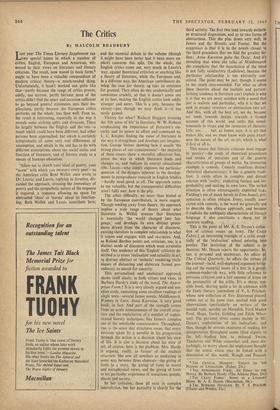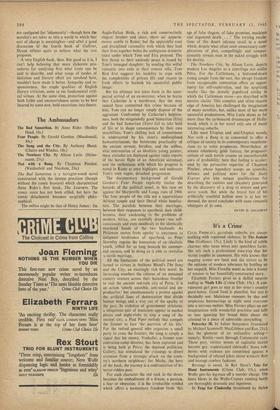The Critics
By MALCOLM BRADBURY
T AST year The Times Literary Supplement ran two special issues in which a number of critics, English, European and American, wit- nessed to their views on literature and literary criticism. The result, now issued in book form,* • "ought to have been a valuable compendium Of modern critical theory—a Much-needed thing. Unfortunately, it hasn't worked out quite like that—partly because the range of critics proves, oddly, too narrow, partly because most of the critics didn't find the space and occasion sufficient to go beyond general statements into their im- plications, partly because the European critics perform, on the whole, less than well. Even so, the result is interesting, especially in the way it reveals some striking splits and divisions. These lie largely between the English and the rest—a result which could have been different, had other persons been approached, but which• is certainly symptomatic of some very real differences of assumption, and which in the end has to do with different assumptions about the social status and function of literature, and of literary study as a means of humane education.
'Allow me to sketch your ideal of poetry, your "norm" with which you measure every poet'—so the American critic Rend Wellek once wrote to Dr. Leavis; and Leavis, replying in Scrutiny, dis- carded the approach, stressing the immediacy of poetry and the sympathetic nature of the response it required, a response allowing no space for abstracted 'ideas' or `norms' about its function- ing. Both Wellek and Leavis contribute here; and the essential debate in the volume (though it might have been better had it been more ex- plicit) concerns this split. On the whole, the English critics come out, very much in Leavis's way, against theoretical criticism or anything like a theory of literature, while the European and, in a different way, the American contributors de- velop the case for theory, oa take its existence for granted. They often do this academically and sometimes crudely, so that it doesn't come out at its best, making the English critics look oddly stronger and surer. This is a pity, because the victory—just though we may think it—is too easily gained.
Victory for what? Richard Hoggart stressing the 'felt sense of life' in literature, W. W. Robson emphasising the importance of literature's sin- cerity and its power to affect and command us, L. C. Knights finding the value of literature in the way it strengthens and develops our imagina- tion, George Steiner showing how it assails 'the strong places of our consciousness'—the majority of these essays show a moralist, affectivist line, stress the way in which literature leads and changes us, and indicate its central educational role. Leavis—who simply explores the particular question of the .dangers inherent in the develop- ments in postgraduate research in English St-tidies —hardly need speak at all. The approach seems to me valuable, but the consequential difficulties aren't fully met; here is the pity.
The other difficulty, no more than hinted at by the European contributors, is more cogent. Though tending away from theory, the approach implies a wide range of theory about what literature is. Wellek stresses that literature is essentially 'the world changed into lan- guage,' and develops its own distinct proce- dures drawn from the character of discourse, existing therefore in complex relationship to what it copies and engages with and re-creates. And, as Roland .Barthes points out, criticism, too, is a distinct mode of discourse which must scrutinise itself. One tendency of this 'English' criticism de- scribed is to stress 'realisation' and actuality in art, to distrust abstract or 'esthetic' rendering (tech- niqUes of distancing and elaborate formal pro- cedures), to search for sincerity.
This personalised and unabstract approach shows itself nicely, in both virtues and vices, in Barbara Hardy's study of the novel, The Appro- priate Form.t It is a very closely argued and sen- sitive study, containing some excellent readings of single texts—several James novels, Middlemarch, Women in Love, Anna Karenina. A very good book, in fact. And part of the strength comes from an acute consciousness of the overall struc- ture and the exploitation of a number of sophis- ticated literary techniques, like James's complex use of the unreliable consciousness. Throughout, too, is the sense that structures mean, that every decision taken by a novelist in his progression through the action is a decision about his view of life. It is also a decision about his view of art, of course; here is the problem. Mrs. Hardy is arguing, really, in favour of the realistic structure. She sees all novelists as mediating in some way between three elements—the giving of form to a story, the giving of form to moral and metaphysical views, and the giving of form to his particular experience of sensations, people, places and society.
In her criticism, these all exist in complex interrelation, but her partiality is clearly for the
* THE CRITICAL MOMENT: ESSAYS ON 111E NATURE OF LITERATURE. (Faber, 25s.) THE APPROPRIATE FORM: AN ESSAY ON ME NOVEL. By Barbara Hardy. (The Athlone Press, 28s.) 'NE CRAZY FABRIC: IRONY AS A LITLRABY MODE. By A. E. Dyson. (Macmillan, 30s.) § Tpla WORICINU NOVELIST. By V. S. Pritchett (Chatto and Winclus, 21s.) third activity. The first two tend towards Eesthetic or structural dogmatism, and so to two forms of abstractness. This she pins down very well, in James and the Brontës and Forster. But the suggestion is that it is in the novels closest to the third procedure that we find the greatest fic- tion: Anna Karenina gains the Oscar. And it's revealing that when she talks of Middlemarch she complains that the incarnation of the ideas is not fully satisfactory (Ladislaw), because the particular relationship is too abstractly con- ceived. The point may be just, though it seems to me much over-extended. For what so often these theories about the realistic and particu- larising tendency in literature can't explain is why it is that we are never satisfied with a novel that just is realistic and particular, why it is that we seek to project structure or abstraction into art. And this, with all the best art, we do, because art tends towards design, towards a • formal account of this world, and seeks this simul- taneously in shape and the resources of rhetoric. Life, yes . . . but, as James says, it is art that makes life, and we must know with great exact- ness the nature of the art, as art, which is what it first of all is.
This means that literary criticism must engage in 'poetics'—the study of rhetorical procedures and modes of imitation and of the generic characteristics of groups of works. An interesting example is comedy. Comedy manifests distinct rhetorical characteristics; it has a generic tradi- tion; it exists often in complex and distant relation with 'reality,' exploiting fantasy and im- probability and making its own laws. The verbal situation is often extravagantly exploited (e.g., Fielding's use of mock-heroic in Torn Jones); pre- sentation is often oblique. Irony, usually asso- ciated with comedy, is the word we generally use to describe this oblique approach, and because it exploits the ambiguity characteristic of literary language it also constitutes a sharp test in
accurate reading. •
This is the point of Mr. A. E. 'Dyson's collec- tion of critical essays on irony, The Crazy Fabric, $ an interesting example of a critic essen- tially of the 'realisation' school entering into poetics. The invitation of the subject is to theorise; Mr. Dyson rejects the opportunity; he, too, is personal and unabstract. An editor of The Critical Quarterly, he offers the virtues of .the journal—lucid, well-deployed argument bring- ing out the essential issues of a text in a genial, common-reader-ish way, with little reference to previous criticism and a fair amount of stress on the personality of the critic. It's a sharp, sen- sible book, sharing quite a lot in common with the lively literary journalism of V. S. Pritchett, whose new collection of New Statesman pieces§ comes out at the same time, packed with good observations (particularly on writers of the second rank, notably on Meredith, Ford Madox Ford, Hugo, Gorky, Golding and Edith Whar- ton). The personal stress comes mainly in Mr. Dyson's exploitation of his radicalism; and thus, though he stresses exactness of reading, his • interpretation throughout seems tilted slightly to the left---leading him to misread Twain, Thackeray and Wilde somewhat, and, more dis- turbingly, to worry about the unpleasant thought that the comic vision may be linked with a detestation of this world. Waugh and Peacock are castigated for 'inhumanity'—though here the novelist's art takes us into a world in which that sort of charge is meaningless—and after a good discussion of the fourth book of Gulliver, Dyson refuses quite to believe what the text proposes. A very English book, then. But good as it is, I can't help believing that more elaborate pro- cedures for analysing first what irony can be said to describe, and what range of modes of imitation and literary effect are involved here, wouldn't have made it better. Sympathy and re- sponsiveness, the staple qualities of English literary criticism, seem to me fundamental criti- cal virtues. At the same time, protection against both foible and amateurishness seems to be best insured by some new, bold excursions into theory.


































 Previous page
Previous page